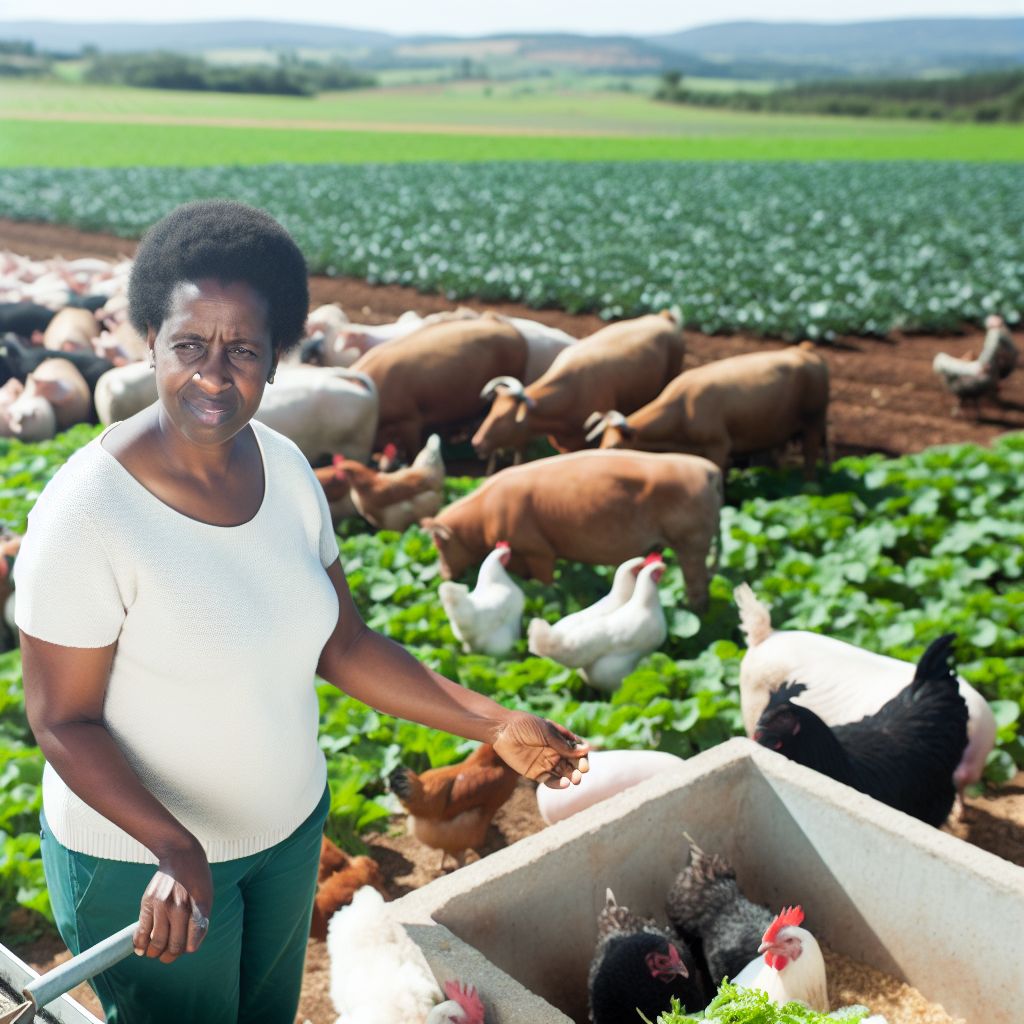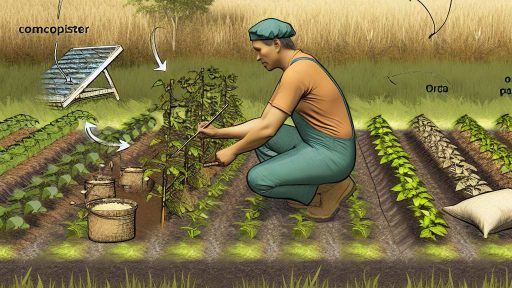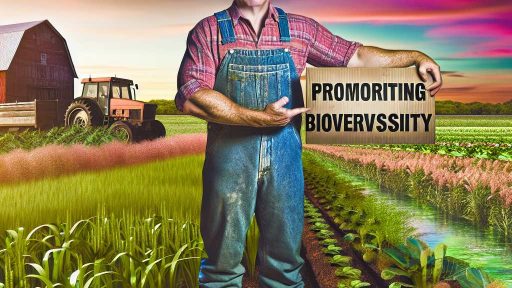Introduction to Integrated Farming Systems
Definition of Integrated Farming Systems
Integrated farming systems (IFS) combine crops and livestock on the same farm.
This approach enhances the efficiency of resource use.
Moreover, it promotes sustainability in agricultural practices.
Importance of Integrated Farming Systems
IFS significantly increases overall farm productivity.
Utilizing livestock in crop production can boost soil fertility.
Additionally, livestock can provide a source of income for farmers.
This system reduces waste while maximizing resource utilization.
Benefits of Livestock Integration
First, livestock contribute manure which enriches soil nutrients.
Next, they help control pests and weeds naturally.
Furthermore, integrating livestock supports better crop rotation practices.
Finally, diverse farming systems enhance economic resilience.
Challenges of Implementing Integrated Farming
Implementing IFS may require initial investment in resources.
Farmers must learn new management practices.
Additionally, there exists a need for proper planning to avoid conflicts.
Despite challenges, the long-term benefits outweigh the hurdles.
Transform Your Agribusiness
Unlock your farm's potential with expert advice tailored to your needs. Get actionable steps that drive real results.
Get StartedBenefits of Integrating Livestock
Nutrient Recycling
Integrating livestock on farms creates an efficient nutrient recycling system.
Livestock manure serves as a natural fertilizer for crops.
This process reduces the need for synthetic fertilizers.
Improved fertilization supports healthier soil and plant growth.
Additionally, animals consume crop residues, converting them into valuable nutrients.
This conversion enhances the overall nutrient content of the soil.
Hence, it promotes a more sustainable agricultural practice.
Soil Health Improvement
Livestock integration significantly boosts soil health.
Animal grazing helps control weeds and reduces competition for crops.
This practice naturally aerates the soil, promoting better root growth.
Furthermore, grazing animals stimulate the growth of beneficial microorganisms.
These microorganisms improve soil structure and fertility.
As a result, the risk of soil erosion decreases over time.
Ultimately, this leads to enhanced long-term agricultural productivity.
Diverse Livestock Systems: Choosing the Right Species for Farm Compatibility
Assessing Farm Goals
Before integrating livestock, clarify your farm’s goals.
Determine if you aim for increased productivity or sustainability.
Consider whether you want to diversify income streams.
Align livestock choices with these defined goals for best results.
Evaluating Land and Resources
Review your land’s suitability for various livestock species.
Consider space availability, pasture quality, and climate factors.
Analyze water access and feed resource sustainability.
These factors will directly impact your livestock’s health and productivity.
Researching Compatible Species
Explore which livestock species best suit your farm conditions.
Cattle offer milk and meat, promoting dairy and beef ventures.
Showcase Your Farming Business
Publish your professional farming services profile on our blog for a one-time fee of $200 and reach a dedicated audience of farmers and agribusiness owners.
Publish Your ProfileGoats thrive in varied environments, providing milk and fiber.
Chickens are excellent for egg production and pest control.
Each species complements different farming operations distinctly.
Understanding Nutritional Needs
Each livestock species has unique nutritional requirements.
Analyze the feed options available on your farm.
Natural forage can reduce feeding costs effectively.
Furthermore, mixed livestock systems can enhance nutrient cycling.
Considering Market Demand
Research local market demands for different livestock products.
Understand consumer preferences for sustainable and ethical farming.
Select species that align with these preferences for better sales.
Adapting to market demand can lead to improved profitability.
Incorporating Livestock into Existing Systems
Integrate livestock with existing crop systems for synergy.
Consider rotational grazing to manage pasture and improve soil health.
Utilize livestock manure to enhance soil fertility naturally.
This approach encourages ecological balance on your farm.
Adapting to Challenges
Be prepared to face challenges in livestock integration.
Monitor health issues, disease management, and environmental impacts.
Adjust your strategies based on performance and feedback.
Flexibility is vital for ensuring long-term success.
Gain More Insights: Financing Options To Expand And Sustain Your Farm Business
Managing Livestock Waste: Utilizing Manure as Fertilizer
Understanding Manure Potential
Manure is a valuable resource for enhancing soil fertility.
It provides essential nutrients to crops.
Farmers can significantly improve their yields by using it effectively.
Types of Livestock Manure
Different livestock produce various types of manure.
Cattle manure is nutrient-rich and beneficial for crops.
Poultry manure is high in nitrogen, making it a potent fertilizer.
Swine manure contains a balanced mix of nutrients.
Understanding each type helps in making informed choices.
Collection and Storage Techniques
Proper collection methods maximize manure benefits.
Consider using deep-pit storage for efficiency.
Use covered storage to reduce odor and leaching.
Regular maintenance ensures manure quality remains high.
Application Methods
Applying manure correctly enhances its effectiveness.
- Spread it uniformly across fields for best results.
- Consider incorporating it into the soil for better nutrient uptake.
- Avoid applying during rainy days to prevent runoff.
Timing matters; apply before planting for maximum impact.
Safety and Environmental Considerations
Following safety guidelines protects both crops and livestock.
Monitor nutrient levels to prevent over-fertilization.
Test soil regularly to adjust application rates.
Utilizing buffer zones can mitigate environmental risks.
Long-Term Benefits
Utilizing manure enhances soil health over time.
It improves organic matter content, leading to better water retention.
Showcase Your Farming Business
Publish your professional farming services profile on our blog for a one-time fee of $200 and reach a dedicated audience of farmers and agribusiness owners.
Publish Your ProfileFarmers often notice increased crop resilience to pests and diseases.
In addition, it reduces reliance on chemical fertilizers, promoting sustainability.
Explore Further: Essential Insurance Policies for Modern Farmers
Crop-Livestock Integration: Strategies for Effective Rotation and Synergy
Understanding Crop-Livestock Integration
Crop-livestock integration enhances farm productivity significantly.
This system leverages the strengths of both crops and livestock.
Moreover, integrating livestock helps in nutrient recycling on farms.
For instance, manure from livestock improves soil fertility.
Additionally, livestock grazing can control weeds effectively.
Strategies for Effective Rotation
Effective rotation involves strategic planning and management.
Start by assessing the specific needs of both crops and livestock.
Implement a diverse cropping system to provide variety.
Rotate between crops that require different nutrients.
For example, follow deep-rooted crops with shallow-rooted ones.
This approach optimizes soil health over time.
Utilizing Cover Crops
Cover crops play a crucial role in crop-livestock integration.
They protect the soil during off-seasons and enhance biodiversity.
Moreover, certain cover crops can provide feed for livestock.
Examples include radishes, clover, and vetch.
Consider their ability to fix nitrogen, benefiting subsequent crops.
Incorporating Livestock into Crop Practices
Introduce livestock into crop fields during specific growth stages.
This practice minimizes compaction while ensuring proper grazing management.
For instance, allow sheep to graze on cover crops.
This reduces costs while improving the health of the soil.
Enhancing Synergy Between Crops and Livestock
Strategic planning fosters synergy between crops and livestock.
Start by creating a balanced farming system.
Focus on minimizing resource waste during both crop production and livestock rearing.
Additionally, recycling nutrients lowers dependency on external inputs.
Tracking Performance and Adjustments
Consistently monitor the performance of both systems.
Keep accurate records of crop yields and livestock production.
Use this data to make informed decisions about future rotations.
Adjust practices based on observed outcomes to enhance productivity.
Case Studies of Successful Integration
Farmers around the world demonstrate successful crop-livestock integration.
For instance, the Smith Farm has doubled its yields through this model.
Similarly, the Garcia Ranch improved soil health and livestock weight gains.
These cases highlight the effectiveness of integration strategies.
Explore Further: Financial Planning for Successful Diversified Agribusinesses
Disease Management: How Livestock Can Improve Crop Resilience
Creating a Balanced Ecosystem
Integrating livestock into crop farming fosters a balanced ecosystem.
This results in improved soil health and enhanced fertility.
Consequently, crops become more resilient to diseases.
Additionally, livestock provide natural fertilizers through manure.
Showcase Your Farming Business
Publish your professional farming services profile on our blog for a one-time fee of $200 and reach a dedicated audience of farmers and agribusiness owners.
Publish Your ProfileThis organic matter boosts microbial activity in the soil.
Reducing Pest Populations
Livestock can play a key role in managing pest populations.
Chickens, for instance, naturally forage for insects.
This reduces the need for chemical pesticides.
As a result, crops experience less stress from pests and diseases.
Enhancing Biodiversity
Diverse livestock breeds contribute to farm resilience.
Different species support varied ecological functions.
This diversity helps disrupt pest and disease cycles.
Moreover, it encourages beneficial microorganisms that protect crops.
Implementing Rotational Grazing
Rotational grazing allows pasture recovery after livestock grazing.
This practice prevents overgrazing and soil degradation.
Healthy pastures contribute to improved crop yields.
Furthermore, this method reduces pathogen load in the soil.
Utilizing Animal Health Strategies
Maintaining animal health leads to better crop outcomes.
Healthy animals produce nutrient-rich manure.
These nutrients promote robust crop growth and strength.
Regular veterinary care prevents the spread of zoonotic diseases.
Case Study: Sustainable Practices at Green Valley Farm
Green Valley Farm showcases the benefits of livestock integration.
They employ a holistic approach to managing disease and pests.
Using rotational grazing techniques, they improve soil health.
The farm also incorporates chickens to manage insects organically.
As a result, they report reduced chemical usage and enhanced yields.
Challenges and Solutions
Integrating livestock poses certain challenges for farmers.
For example, managing livestock movement can be complex.
Farmers can employ fencing and water sources to guide animals.
Education on disease management is crucial for success.
Furthermore, collaborating with local agricultural experts can help.
Learn More: Labor Management Strategies For Cost-Effective Farming

Economic Advantages
Cost-Benefit Analysis of Integrated Systems
Integrating livestock into farming systems can yield significant economic benefits.
Farmers often see a reduction in input costs when livestock and crops co-exist.
This integration can lead to improved nutrient cycling on the farm.
Additionally, livestock provide manure, which can enhance soil fertility.
Ultimately, healthier soil results in higher crop yields.
Increased Revenue Streams
Having livestock diversifies a farmer’s income sources.
Farmers can sell meat, milk, eggs, and other animal products.
This diversification can help stabilize income fluctuations.
Moreover, value-added products enhance profitability.
For instance, cheese and yogurt production can generate higher margins.
Reduction of Waste
Integrated systems reduce waste by utilizing by-products efficiently.
Crop residues can serve as feed for livestock.
Showcase Your Farming Business
Publish your professional farming services profile on our blog for a one-time fee of $200 and reach a dedicated audience of farmers and agribusiness owners.
Publish Your ProfileThis utilization minimizes reliance on external feed sources.
Furthermore, livestock waste can replenish soil nutrients effectively.
Consequently, farmers reduce the need for synthetic fertilizers.
Enhanced Risk Management
Integrating livestock offers better risk management for farmers.
Depending solely on crops exposes farmers to market volatility.
Conversely, livestock can provide a buffer during crop failures.
Products like dairy and meat can sometimes command premium prices.
This resilience supports financial stability for farming operations.
Government Incentives and Support
Many governments provide incentives for integrated farming practices.
Subsidies can offset the initial costs of starting mixed operations.
Additionally, grants may support sustainable farming practices.
Hence, engaging in integrated systems can be financially advantageous.
Farmers should explore local and national resources available to them.
Challenges and Solutions: Addressing Common Hurdles in Integration
Identifying Common Challenges
Integrating livestock into farming presents multiple challenges.
Farmers often encounter resistance to changing traditional practices.
Additionally, inadequate knowledge about livestock management can hinder progress.
Limited resources for training and education add to the difficulty.
Moreover, animal welfare concerns frequently arise during integration.
Resistance to Change
Resistance to change can stem from deep-rooted beliefs.
Farmers may feel uncertain about new practices affecting productivity.
To address this, open communication is crucial.
Sharing successful case studies will ease concerns.
Encouraging peer-to-peer discussions fosters a supportive environment.
Education and Training Solutions
Providing proper education is essential for successful integration.
Organizing workshops and training sessions will enhance knowledge.
Moreover, online resources can supplement traditional training methods.
Farmers should be encouraged to participate in agricultural extension programs.
These initiatives will equip them with necessary skills and strategies.
Resource Allocation
Limited resources can impede the integration process.
Farmers need access to funding and technical assistance options.
Governments and NGOs should collaborate to provide such resources.
Additionally, creating community resource hubs can ensure easy access.
Pooling resources within farmer cooperatives can also alleviate this issue.
Addressing Animal Welfare Concerns
Animal welfare is a critical aspect of livestock integration.
Farmers must understand ethical treatment practices for their animals.
Providing information about humane practices can build trust.
Regular workshops on animal care will help ensure well-being.
Furthermore, monitoring systems can assist in maintaining standards.
Encouraging Sustainable Practices
Sustainability should be a priority in livestock integration.
Implementing rotational grazing can improve land health.
Showcase Your Farming Business
Publish your professional farming services profile on our blog for a one-time fee of $200 and reach a dedicated audience of farmers and agribusiness owners.
Publish Your ProfileUsing livestock for natural fertilizer reduces chemical dependency.
Also, developing agroecological systems can enhance biodiversity.
Many farmers have found success using integrated pest management techniques.
Securing Market Access
Finally, market access is vital for the success of integrated systems.
Farmers must be informed about potential markets for livestock products.
Establishing partnerships with local businesses is beneficial.
Furthermore, participating in farmers’ markets can increase visibility.
Engaging with consumers about the benefits of integrated farming will boost demand.
Case Studies: Successful Examples of Livestock Integration in Various Regions
Integration in North America
In North America, farmers have successfully integrated livestock with crop production.
This approach has led to improved nutrient cycling on the farm.
For example, the Smith family farm in Iowa practices mixed cropping and livestock raising.
They rotate cattle through their cornfields to enhance soil fertility.
Consequently, this practice reduces the need for synthetic fertilizers.
Integration in South America
In Brazil, the integration of livestock and agriculture has gained popularity.
The Souza farm exemplifies this trend through its innovative practices.
They utilize cattle to graze cover crops, improving soil structure.
This method not only benefits the cattle but also increases yield in subsequent crops.
Moreover, it enhances carbon sequestration within the soil.
Integration in Europe
European farmers are increasingly adopting integrated farming systems.
The Müller farm in Germany showcases this by combining dairy cows with vegetable production.
Cows graze in rotation with vegetable plots, which reduces pests and weeds.
This strategy has led to higher vegetable quality and healthier livestock.
Additionally, it optimizes land use and reduces operational costs.
Integration in Asia
In Asia, integrated farming systems are transforming agricultural practices.
The Chen family in China successfully integrates fish farming with rice cultivation.
They raise fish in flooded rice fields, which improves crop yields.
The fish provide natural pest control while fertilizing the crops organically.
Such methods contribute to sustainable food production in the region.
Integration Strategies Across Regions
Many successful farms utilize similar strategies to integrate livestock and crops.
- Rotational grazing enhances soil health.
- Cover cropping improves biodiversity.
- Combining livestock with crop production reduces waste.
- Integrating aquaculture promotes resource efficiency.
These strategies demonstrate the adaptability of livestock integration in various regions.
Farmers can replicate these successes to enhance their agricultural productivity.
Additional Resources
Climate-smart agriculture (CSA) is an integrated approach to …




